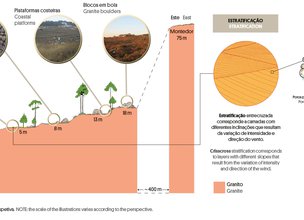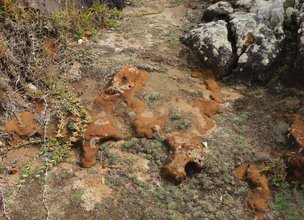MILLENNIAL FOSSILIZED DUNES
71 thousand years ago, this area that you now visit was a wide dune field, today witnessed by reddish sandstone relics, consolidated in hematite (iron oxide). During this period the sea level would be about 40 m below the current one and the coastline more than 10 km from this location.
The dunes are formed by the accumulation of deposited sands, carried by the wind or water, in this case exclusively by the wind. The orographic characteristics of the continental platform, then exposed by the low sea level, allowed free and long-distance transport of the wind grains from the coastline, depositing themselves against the marginal terrain. An example of this behavior, although much more recent and motivated by the climate crisis of the Little Ice Age, can be seen at the Natural Monument of Faro de Anha Climbing Dunes.
References:
Carvalhido (2012). O Litoral Norte de Portugal (Minho-Neiva): evolução paleoambiental quaternária e proposta de conservação do património geomorfológico. Tese de Doutoramento, Universidade do Minho, 564 p.
71 thousand years ago, this area that you now visit was a wide dune field, today witnessed by reddish sandstone relics, consolidated in hematite (iron oxide). During this period the sea level would be about 40 m below the current one and the coastline more than 10 km from this location.
The dunes are formed by the accumulation of deposited sands, carried by the wind or water, in this case exclusively by the wind. The orographic characteristics of the continental platform, then exposed by the low sea level, allowed free and long-distance transport of the wind grains from the coastline, depositing themselves against the marginal terrain. An example of this behavior, although much more recent and motivated by the climate crisis of the Little Ice Age, can be seen at the Natural Monument of Faro de Anha Climbing Dunes.
References:
Carvalhido (2012). O Litoral Norte de Portugal (Minho-Neiva): evolução paleoambiental quaternária e proposta de conservação do património geomorfológico. Tese de Doutoramento, Universidade do Minho, 564 p.

Evolution of the ancient dune
Location
Montedor, Carreço
Coordinates
Lat: 41.7495336
Long: -8.8794956
Hello little one!
I'm Piquinhos and I can help you learn more about the Geopark!
Technical details
MILLENNIAL FOSSILIZED DUNES
71 thousand years ago, this area that you now visit was a wide dune field, today witnessed by reddish
sandstone relics, consolidated in hematite (iron oxide). During this period the sea level would be about
40 m below the current one and the coastline more than 10 km from this location.
The dunes are formed by the accumulation of deposited sands, carried by the wind or water, in this case exclusively by the wind. The orographic characteristics of the continental platform, then exposed by the low sea level, allowed free and long-distance transport of the wind grains from the coastline, depositing themselves against the marginal relief.
An example of this behavior, although much more recent and motivated by the climate crisis of the Little Ice Age, can be seen at the Natural Monument Faro de Anha Climbing Dunes.
References and scientific articles
Carvalhido, R. (2012). O Litoral Norte de Portugal (Minho-Neiva): evolução paleoambiental quaternária e proposta de conservação do património geomorfológico. Universidade do Minho.
NGRIP Members (2004). High-resolution record of Northern Hemisphere climate extending into the Last Interglacial period. Nature 431, pp. 147–151.
Evolution of the ancient dune
Child Mode
Discover the geopark in a simpler format, aimed at the little ones.
Clique ENTER para pesquisar ou ESC para sair
